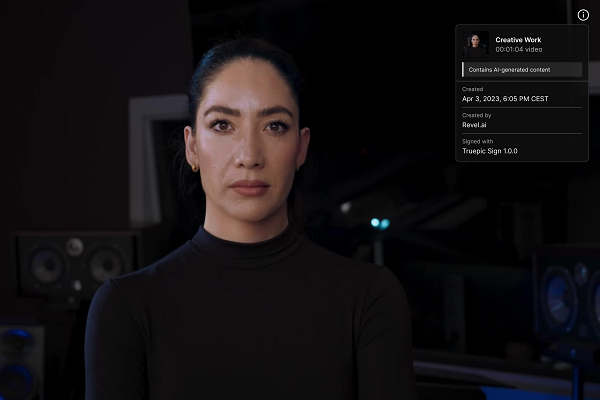Deepfake Video Showcases Authenticating Watermark and Warns Against Synthetic Media’s Disinformation Power
A deepfake of generative AI expert Nina Schick stars in a new video outlining how deepfakes can spread information while showcasing a new tool to combat that danger. Schick worked with synthetic media developer Revel.ai and digital identity security provider Truepic to produce the deepfake video and a virtual watermark authenticating its inauthentic origins.
Transparent Deepfake
“Some say that truth is a reflection of our reality.” We are used to defining it with our very own senses. But what if our reality is changing? What if we can no longer rely on our senses to determine the authenticity of what we see and here? We’re at the dawn of artificial intelligence, and already the lines between real and fiction are becoming blurred,” Schick’s AI avatar says in the film right before morphing into a different person. ” A world where shadows are mistaken for the real thing, and sometimes we need to radically change our perspective to see things the way they really are.”
Schick’s synthetic self appears in the new “Mirror of Reflection” video to talk about how deepfakes can trick people with hyperrealistic images like the one in the film. Revel and Truepic counter that reality distortion with a transparent digital signature identifying that the video uses synthetic media, one that they claim can’t be altered or removed without leaving evidence behind. Creators that choose to use the tools can add details to synthetic media with any details of how they generated and edited it. Revel created the virtual version of Schick with her permission, and Truepic provided the cryptographic signature. Content creators interested in synthetic media but wanting to avoid accusations of trickery could embed the virtual watermark in their images and films to ensure there’s no confusion.
“The integrity of our information ecosystem relies on our ability to have a shared sense of reality, and that starts with responsible disclosure of where content originates from,” Truepic CEO Jeff McGregor said. “Our partnership with Revel.ai and Nina Schick highlights that a more authentic internet is possible today by transparently marking whether content is human or computer-generated. This advancement opens up the ability for AI-generated content to flourish, while mitigating the potentially devastating impact on our information ecosystem and society at large.”
Real Synthetics
Deepfake creations have bloomed as synthetic media technology development accelerates. Images and videos realistic enough to fool casual glances are now a mainstream viral attraction shared on social media by millions. Synthetic image generator Midjourney even paused access to the trial version of its new Midjourney v5 text-to-image engine because of it. The issues aren’t limited to synthetic visuals either. Voice cloning can make audio deepfakes good enough to fool some biometric tests and the untrained ears of a concert crowd. Resemble AI is experimenting with an audio version of a watermark to tag AI-generated speech without compromising sound quality. They’re essentially using a very soft sound that people won’t notice but that is encoded with information that a computer could decipher The identification tones are hidden within the sounds of speech.
“When used well, AI is an amazing tool for storytelling and creative freedom in the entertainment industry. The power of AI and the speed at which it’s developing is something the world has never seen before,” Revel.ai creative director Bob de Jong said. “It’s up to all of us, including content creators, to design an ethical, authenticated, and transparent world of content creation so we can continue to use AI where society can embrace and enjoy it, not be harmed by it.”
Follow @voicebotaiFollow @erichschwartz
Donald Trump Shares Deepfake Photograph of Himself on Social Media
Resemble AI Creates Synthetic Audio Watermark to Tag Deepfake Speech
David Guetta Plays Deepfake Eminem With AI-Generated Lyrics and Voice at Concert









